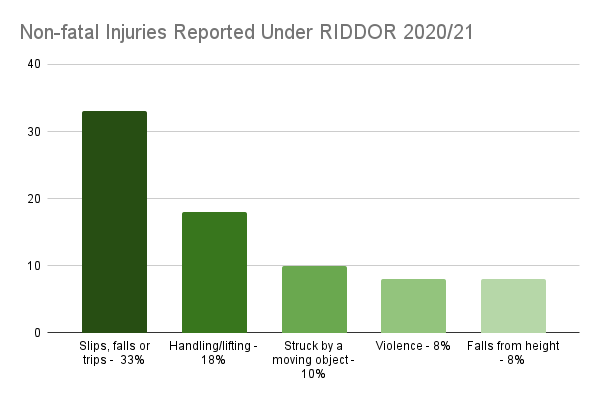Find Out If You Could Make A Workplace Injury Claim
If you’ve been injured as the result of negligence, you may be able to make a workplace injury claim. This guide can help you understand the process.
We look at the laws that protect your safety at work and how an employer could be liable if they breached those laws. We also look at how compensation is calculated, as well as some of the different accident types that could occur as a result of negligence.
Furthermore, we discuss how a No Win No Fee solicitor from our panel could assist you with your potential claim for workplace injury compensation without needing an upfront or ongoing fee for their services.
If you would prefer to talk to someone in person, our supportive and expert team is on hand. Simply:
- Call our advisors on 020 3870 4868
- Fill in our online form
- Or speak to an advisor on our ‘live support’ option for immediate free information and help

Select A Section
- Am I Eligible To Make A Workplace Injury Claim?
- What Could I Make A Workplace Injury Claim For?
- How Can My Employer Prevent Workplace Injuries?
- What Steps Should I Take To Make A Workplace Injury Claim?
- Workplace Injury Claims Calculator
- Make An Accident At Work Claim With A Specialist No Win No Fee Solicitor
Am I Eligible To Make A Workplace Injury Claim?
Anyone who can prove that they suffered an accident at work as a result of negligence that left them injured could have grounds to start a workplace injury claim. Employees, sub-contractors, and even self-employed people whilst on construction sites can be eligible to make a claim if injured as a result of negligence.
All UK employers have strict legal responsibilities under the Health and Safety At Work, etc Act 1974 to protect employee safety as far as reasonably practicable. In order to claim compensation, you need to show that you sustained the injury as the result of a breach of duty of care.
Other eligibility criteria include making a personal injury claim within the time limit. You generally have three years in which to start a claim; however, exceptions can apply in some circumstances. Find out more about how long you have to start a claim by speaking with our team.
Workplace Injury Statistics
Below, our graph shows as percentages non-fatal workplace injury statistics that happened during the period 2020/21 and were reported to the Health and Safety Executive (HSE) through the RIDDOR (Reporting of Injuries, Diseases and Dangerous Occurrences Regulations 2013).

As you can see, slips, trips and falls made up the highest percentage of accident types reported. This was followed by injuries sustained when handling or lifting.
What Could I Make A Workplace Injury Claim For?
Obviously, each workplace differs, and depending on the nature of the business they could present their own set of particular hazards. Some general examples that could happen across all areas are as follow:
- A slip, trip or fall on ice that occurred because of a breach of duty of care.
- Manual handling injuries sustained because you were not given the proper training to carry out your role.
- Tripping over a wire or computer cable that was left trailing across a walkway and twisting your ankle
- Soft tissue wounds from malfunctioning machinery that is not properly serviced.
- Falling downstairs because of a faulty handrail that your employer knew was broken.
This list is not exhaustive. There are a number of different ways that you could be injured as a result of negligence that we have not mentioned here. Get in touch with our team for more information on making a workplace injury claim.
How Can My Employer Prevent Workplace Injuries?
As mentioned, your employer has a duty to take reasonable and practicable steps to protect you from harm at work under HASAWA. Some steps they can take to uphold this duty and prevent workplace injuries include:
- Maintaining equipment so that it is safe to use.
- Conducting regular risk assessments to spot health and safety issues and acting on the findings.
- Providing appropriate and necessary Personal Protective Equipment (PPE) for the role.
- Providing adequate training so that employees are able to carry out their duties safely.
If you were injured as a direct result of a breach of this duty of care on the part of your employer, you may be able to claim compensation. Call us today to find out whether you’re eligible to make a workplace injury claim.
What Steps Should I Take To Make A Workplace Injury Claim?
There are certain steps that you can take after being involved in an accident at work due to negligence that could strengthen your claim. These include:
- Report the incident and enter details of the incident into the accident book. It’s a legal requirement for a company that employs 10 or more people to have an accident book.
- Take photos of the accident scene to show any hazards that caused it to happen.
- Ask a witness if they can give a statement at a later date and collect their details. However, you may still be able to claim even if there was no witness to your accident.
- Request CCTV footage that shows the incident taking place.
- Seek legal advice. This isn’t a requirement, but you might find that it makes the process of claiming easier.
For more information on the steps you can take after being injured in an accident at work, speak with an advisor today. You could be connected with a solicitor to work on your workplace injury claim.
Workplace Injury Claims Calculator
Settlements following successful personal injury claims could consist of two parts. The part of your payout that compensates for the pain, suffering, or loss of amenity you experience after your injuries is known as general damages.
The first step to calculating general damages for your workplace injury claim is to arrange for a medical assessment. A personal injury solicitor can help you do this.
Once an independent professional has looked at you, they can put your injuries into a medical report. Guideline compensation brackets from the Judicial College Guidelines are then used to help value your claim. We have included some examples below. The first entry is not from the JCG. Please use these figures as a guide only.
| Injury | Severity | JC Guidelines award bracket | notes |
|---|---|---|---|
| Multiple Very Severe Injuries with Monetary Losses | Very Severe | Up to and above £500,000+ | A compensation award for the mental and physical impact of multiple very severe injuries with monetary losses, such as lost income and care costs. |
| Neck | Severe (a) (i) | In the region of £139,210 | There will be little to no movement in the neck despite wearing a collar 24 hours a day for a number of years. |
| Shoulder | Serious (b) | £11,980 to £18,020 | Nerve damage and restricted movement. |
| Elbow | Severe (a) | £36,770 to £51,460 | Injuries of a severely disabling nature |
| Wrist | Serious (b) | £22,990 to £36,770 | Permanent disability, some remaining useful movement |
| Leg | Less serious (c) (i) | £16,860 to £26,050 | Includes fractures from which recovery is incomplete. |
| Knee | Severe (a) (i) | £65,440 to £90,290 | Ligament damage, disrupted joint and serious on-going pain |
| Ankle | Modest (d) | Up to £12,900 | Mild fractures, sprains and strains |
| Facial disfigurement | Very severe (a) | £27,940 to £91,350 | Disfiguring scars causing a severe psychological reaction |
Special Damages In A Workplace Injury Claim
As well as these, if you have proof like receipts and wage slips, it can be possible to claim for financial losses. This part of your claim is called special damages and can cover:
- Loss of earnings
- Travel costs for hospital appointments
- The cost of domestic help at home as you recover
- Medical costs for treatment that you cannot get on the NHS
Call and discuss your situation with our team and they could alert you to other potential costs owed back to you. Furthermore, an advisor could connect you with a No Win No Fee solicitor from our panel provided you have a valid case.
Make An Accident At Work Claim With A Specialist No Win No Fee Solicitor
It’s important to remember that anyone can represent themselves in a workplace injury claim. However, legal jargon can become complex and the case may require a good deal of time and attention. This could be too much on top of trying to recover from your injuries and a personal injury lawyer could help.
A No Win No Fee agreement sets out the conditions that your lawyer needs to meet before they are paid. When a solicitor works under an agreement like this with you, the benefits include:
- No cost to hiring a personal injury lawyer like this
- No fees to pay as the case moves ahead
- If the case fails, there are no fees to pay your No Win No Fee lawyer at all
If your claim is a success, then a fee will be deducted from your compensation by your lawyer. This is legally capped meaning you always receive the majority of the payout.
Connect with our team on the details below. They could put you in touch with a No Win No Fee lawyer from our panel today. Just:
- Call our advisors on 020 3870 4868
- Write to us using our online form
- Or use the ‘live support’ option below.

References
Below are some further resources to help with your workplace injury claim. Please get in touch if we can help with anything as you read them:
-
- Learn more about an accident at work claim
- Understand who exactly pays your compensation after a work-related injury
- Further help on how to prove your personal injury claim
- Do you need advice about Statutory Sick Pay (SSP) while off work?
- There are resources from the NHS about when to call 999
- Lastly, you can refer to the Limitation Act 1980 for the time limits that apply to starting your claim
Writer FE
Checked by NC




